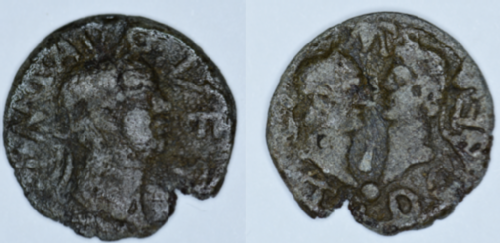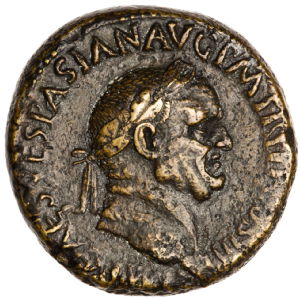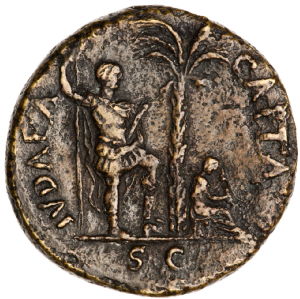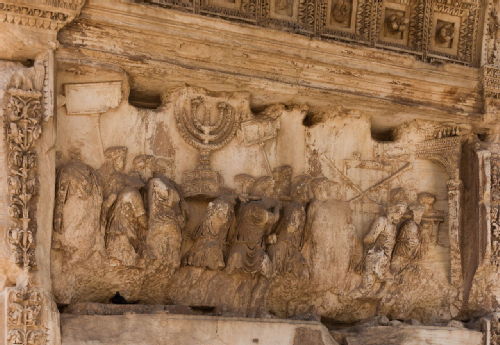All 2 entries tagged Titus
View all 3 entries tagged Titus on Warwick Blogs | View entries tagged Titus at Technorati | There are no images tagged Titus on this blog
May 01, 2021
A Flavian token in the Hunterian Museum, Glasgow
Writing about web page https://coins.warwick.ac.uk/token-specimens/id/hunterian.RLT24

Lead token, 19mm, 12h, 2.74g. Side a: Laureate head of Vespasian right; IMP AVG VES around. Side b: Laureate heads of Titus (on left) and Domitian (on right) facing each other; IMP above and T DO CAES below.
TURS 40, The Hunterian Museum, RLT 24. Photo by author.
Amongst the Roman lead tokens now in the Hunterian Museum in Glasgow is a piece that presents the Flavian dynasty. On one side of the token we find a portrait of the emperor Vespasian, accompanied by a legend that names him. On the other side we find his sons, Titus and Domitian, facing each other with a globe between them. The token recalls coinage that was struck in Vespasian's name in AD 70 (RIC II.12 Vespasian 15–16, 37). An example of this coinage is shown below.

Silver denarius, 7.5mm, 6h, 3.22g. Obverse: Laureate head of Vespasian right, IMP CAESAR VESPASIANVS AVG around. Reverse: Bare head of Titus on left facing bare head of Domitian on right, CAESAR AVG F COS CAESAR AVG F PR around.
RIC II.12 16, American Numismatic Society 1944.100.39897.
At first glance, the coin and token are very similar: both show Vespasian on one side and his sons on the other, with accompanying legends naming the individuals shown. But upon closer examination there are also important differences. On the token both Titus and Domitian are shown wearing laurel wreaths ("laureate"); one can see the ties of the wreaths flowing down behind their respective necks. On the coin they are bare-headed. On the token a globe is placed between the busts, absent on the coin issue. This globe, and the representation of Vespasian's sons, recalls an earlier token issue showing the twin sons of Drusus the Younger, Tiberius Gemellus and Tiberius Germanicus, shown below.

Orichalcum token, 21mm, 4.67g, 12h. Obverse: Two young busts facing each other, each with a star above (the twin sons of Drusus the Younger), globe in between them. Reverse: VIIII within dotted border within wreath.
Buttrey B19/VIIII, © The Trustees of the British Museum, R. 4456.
The IMP on the token (an abbreviation of the title imperator) sits above the heads of Titus and Domitian. Who the title refers to is ambiguous; it may refer only to Titus, but since both Titus and Domitian are laureate it perhaps references both of them. Both Titus and Domitian also had the title CAESAR, abbreviated to CAES on the token and placed on the right hand side. In sum, although the token was likely inspired by the coin type, the makers did not merely copy the coin. They adapted the 'official' image and altered it; the resulting tokens were presumably given to an audience who were receptive to the alterations.
The precise occasion that motivated the creation of this token series is not known. It might have been created in connection to Vespasian's triumph (an important moment in which the new Flavian dynasty was presented to Rome), or at some later occasion. Another token issue also shows the laureate heads of Titus and Domitian, this time without the globe (TURS 41-42). On the other side of this token issue we find a horse rider carrying a spear accompanied by the legend IMP AV VES. The reference to Vespasian suggests that it is the emperor shown on horseback here. Whatever the occasion for the tokens showing laureate Titus and Domitian, their existence provides us with an insight into a particular vision of the Flavian dynasty not found on coinage or other media. This particular imagery of the imperial family would have contributed to the emotions, experiences and memories of the events in which the tokens were used.
This month's blog was written by Clare Rowan, as part of the Token Communities in the Ancient Mediterranean Project.
January 01, 2021
Glorification and personification on the Judaea Capta coinage
When Titus captured Jerusalem and destroyed the Second Temple in 70 AD, the triumph awarded to him and his father Vespasian was swathed in luxury and decadence. This was a victory that celebrated the violent result of years of strained relations between Jerusalem and Roman governance. The taking of Jerusalem involved a long and bloody siege resulting in the deaths of a reported 1.1 million people, most of whom where Jewish (Josephus, Jewish Wars 6.9.3). Those who survived were paraded through the streets of Rome, and the spoils of war contributed to the building of the iconic Flavian amphitheatre we know as the Colosseum.
The Roman victory, as so often was the case, was advertised upon the contemporary coinage. As travelling propaganda, these coins reinforced the idea of Roman supremacy and the might of the empire. The Judaea Capta type was minted in various denominations in the name of Vespasian and both of his sons, and in spite of several variations in design the overall message remained the same.
 |
 |
Sesterius of Vespasian, AD 71, RIC II.12 167, reproduced courtesy of the American Numismatic Society (inv. no.0000.999.18073).
The legend on the reverse states IVDEA CAPTA ,‘Judaea conquered’, and the coin depicts a woman seated beneath a palm tree, with a man, interpreted as the emperor, watching. The woman is Jerusalem, her hand to her cheek in a traditional expression of mourning. She is wearing civilian dress, and reflects the prophecy of Isaiah 3.26: ‘…And her gates shall lament and mourn, and she being desolate shall sit upon the ground’ (Young (1992) 170). By contrast, the male watching is standing, and still wears his armour, his foot placed on a helmet. The palm tree sets the scene of the victory in Judaea.
Personification was often used by Rome to reflect victory, as it expresses an effective message that was simple to comprehend. In this case, the use of opposing characteristics of the figures on the coins is extremely powerful in conveying the intended message. Jerusalem is depicted as female, and therefore as weak and submissive in contrast to the male figure representing Rome. The male figure, often interpreted as Vespasian himself, stands in reference to his elevated position over the woman in his victory. Where the woman is unarmed, the man is still dressed for battle in a reflection of victory
Other versions of this coin replace the armoured man with a winged Victory, or sometimes a bearded man with his hands tied behind his back. The latter is a depiction of a soldier of Jerusalem, bearded to reflect his ‘barbarian’ status in the eyes of the Roman Empire. His weapons and armour are laid down beside him in an image of defeat (RIC II.1² Vespasian 159). The legend also has variations, such as IVDAEA DEVICTA, ‘Judaea defeated’ (RIC II.1² Vespasian 1120), or DE IVDAEIS ‘[the booty] from the Judaeans’ (RIC II.12 1179) in reference to the wealth stolen from the temple of Jerusalem. The palm tree has been interpreted as a representation of Rome victorious over Judaea.
The coin is one of many examples of media expressing the Flavian victory over the province of Judaea, including the arch of Titus which still stands proudly at the entrance to the Roman forum today. In a passing glance it appears as just another Roman victory arch, but if you take a closer look you can spot iconography relating to the siege, including a parade of people carrying aloft a menorah from the temple.

Close-up of the menorah being carried in the victory parade on the Arch of Titus .Image from WikimediaImages from Pixabay.
The Judaea Capta coinage reflects an important moment in the history of Rome, and likewise the history of Jerusalem. The Great Revolt resulted in a mass of deaths, displacement and enslavement. The minting of Judaea Capta coinage therefore becomes part of the Roman narrative of glorified victory and imperialism in the Flavian period.
 |
This month's entry was written by Rebecca Preedy. Rebecca is an Ancient History and Classical Archaeology with Study Abroad student. She is completing her final year at Warwick after a year abroad at La Sapienza. Since studying in Rome, Rebecca has been fascinated by the ancient city and is hoping to continue her studies with a postgraduate degree in Roman Material Culture.
Select Bibliography
• Josephus, The Jewish War, trans. G. Williamson (London: Penguin)
• The Holy Bible: King James Version (Massachusetts: Hendrickson 2004)
• Carradice, I. (2012) ‘Flavian Coinage’ in The Oxford Handbook of Greek and Roman Coinage ed. W.E. Metcalfe
• Claridge, A. (2010) Rome: An Oxford Archaeological Guide (Oxford: University of Oxford Press)
• Moresino-Zipper, A. (2009) ‘Die Judaea-Capta-Münze und das Motiv der Palme. Römisches Siegessymbol oder Repräsentation Judäas?’ in Jerusalem und die Länder: Ikonographie - Topographie - Theologie eds. A. Moresino-Zipper, G. Theißen, H.U. Steymans, K.M. Schmidt, S. Ostermann
• Stevenson, T.R. (2010) ‘Personifications on the coinage of Vespasian (AD 69-79)’ Acta Classica 53:181-205
• Young, E.J. (1992) The Book of Isaiah (Michigan: William B. Eerdmans Publishing Company)
 Clare Rowan
Clare Rowan

 Please wait - comments are loading
Please wait - comments are loading

 Loading…
Loading…

